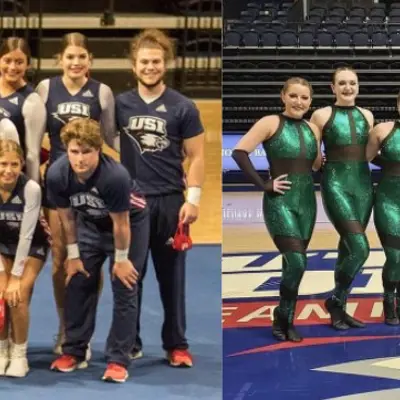
Adjusting to adversity: USI Cheer and Dance Teams earn top finishes at virtual national competitions
May 4, 2021
Having to compete virtually for their respective nationals' performances was the last thing the USI Cheer and Dance Teams wanted to consider after a year of what seemed like everything being taken away. But the pandemic-as we've heard so many times over the last year-had other plans. With no guidelines at the Universal Cheerleaders Association (UCA) College Nationals or the College Classic National Invitational in play that adhered close enough to USI's COVID-19 guidelines, USI Athletic Director Jon Mark Hall and other University leadership members had no choice but to break the tough news to both teams. "I know the news we delivered about competing virtually is not what they wanted to hear, but they handled it with grace and dignity and kept moving forward," Hall says. "The Cheer and Dance Teams work extremely hard, and everyone hated that we had to make the decision."
Though both teams were disappointed and frustrated with yet another adjustment to their seasons, they accepted their new realities and were determined to take on the virtual competition just as they would the in-person competition. "As we got closer to the competition deadline, my mindset [on the virtual competition] changed into 'It's better than nothing,'" Lexi McLemore, a junior flyer on the Cheer team reflects. "With a super young team and a lot of people still new to competing, I soon felt it was for the best that we couldn't go. Competing virtually allowed the freshmen on the team to get an understanding of how important nationals actually are."
Maggie Brock, a senior on the Dance Team, worked all season toward her last in-person performance the pandemic hadn't yet wrecked. After hearing the news, she decided she and her team were still going to make the most of the virtual competition. "As we got closer to nationals, it felt more like a regular season," she says. "I still got nervous before every routine run through."
As nerves settled for both teams, the work toward award-winning routines continued. Moving to a virtual competition format caused both teams to have to adjust their performance deadline by nearly two weeks, shortening the time they had to perfect their routines. The Cheer Team started putting various stunt and tumbling pieces of their routine together in January, and the Dance Team started prepping for their multi-layered performance-including jazz, hip hop and other styles of dance-in November. The Cheer and Dance Teams go through a similar process when building their routines. They start with the basics, then build their foundational skills into complex skills. Once these complex skills are mastered, the athletes start choreographing select portions of their routines. After dozens of practices, they connect all the pieces, and their two-minute routines come alive.
"We took advantage of as much time as we could get," Megan Murphy, Cheer Head Coach, says. "We practiced everyday beginning in March, and we also had two-a-day practices to drill skills, transitions and overall effectiveness."
"We drill technique at practices," Jennifer Parker, Dance Head Coach, says. "Then, we get to a point where we feel confident with it, and we start to clean it [the routine]."
Unlike the in-person competitions, competing virtually allowed both teams to record their routines as many times as needed to get the best take for submission. At their respective in-person competitions, both teams only get one shot to show off their routines before being judged on whether they should move on to the final round. On top of unlimited recordings, the Cheer and Dance Teams were able to have audiences in the Screaming Eagles Arena at their designated tapings-something that isn't always possible when the teams are on the road performing.
"It was so exciting to have an audience at the virtual taping. I think I can speak on behalf of the team when I say it gave us more of a 'competing at nationals' feeling," Kamren Mullican, a sophomore on the Cheer Team, says. "It got some adrenaline pumping and my family got to watch me. That was the most I could ask for."
"It was nice to have the audience there, and it helped make the taping feel more like a regular national performance instead of another performance for Jenn, our coach," Brock says. "Having that support while performing made it easier to get through the routine and made the atmosphere match that of a regular national competition."
The Cheer Team ended their season with a fourth-place finish in the Small Coed Division I division, which marks the team's highest placement since they finished second in 2014. The Dance Team concluded with a fifth-place finish in the Virtual Open Team Performance division with a team of five athletes after a year off from competing due to the pandemic.
Though virtual national competitions were not ideal for either team, athletes on the Cheer and Dance Teams grew exponentially in their skills and mindset and earned top honors while doing so. "We were very thankful that the competition organizers did allow for virtual competition and our programs took advantage of that opportunity," Hall says. "We are so very proud of what both teams have accomplished this year through such adversity."
This feature was written by Kaylee Johnson, Graduate Assistant in University Communications.